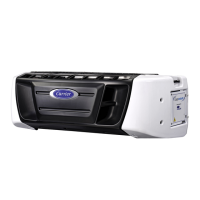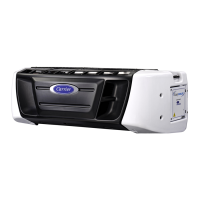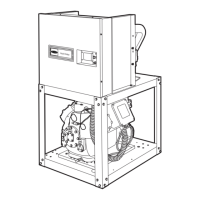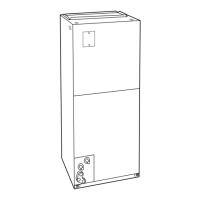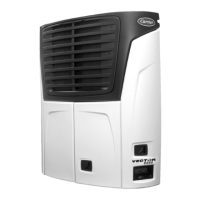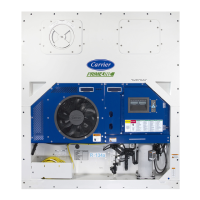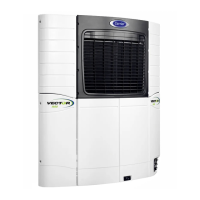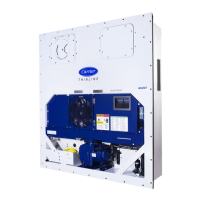T -309 4-6
noid valve changing from economized operation to
unloaded operation. (As shown i n Figure 4-5)
d. Thecontrollermonitors thesupply air. Oncet hesup-
plyairfallsbelowsetpointthecontrollerperiodically
recordsthesupplyairtemperature,setpointandtime.
Acalculationisthenperformedtodeterminetemper-
ature drift from set point over time.
e. If the calculation determines cooling is no l onger re-
quired,contactsTDandTNareopenedtode-energize
compressormotorandcondenserfanmotor.Thecool
light is also de-energized.
f. Theevaporatorfanmotorscontinuetoruntocirculate
air t hroughout the container. The in-range light re-
mains illuminated as long as the supply air is within
tolerance of set point.
g. If the supply air temperature increases to 0.2_C
(0.4_F) above set point andthe threeminuteofftime
has elapsed, relays TD, TU and TN are energized to
restart the compressor and condenser fan motors in
unloaded operation. The cool light is also illumi-
nated.
CONTROL TRANSFORMER
POWER TO
CONTROLLER
SIGNAL TO
CONTROLLER
ENERGIZED
DE--ENERGIZED
FOR FULL DIAGRAM AND
LEGEND, SEE SECTION 7
NOTE: HIGH SPEED EVAPORATOR FAN SHOWN. FOR LOW SPEED
CONTACT TE IS DE--ENERGIZED AND CONTACT TV IS ENERGIZED
TD
T6
PA
PB
T6
PB
PA
USV
ESV
TU
TS
Figure 4-5 Perishable Mode Heating
4.9.3 Sequence Of Operation --
Perishable Mode Heating
a. Ifthe airtemperature decreases 0.5_C (0.9_F)below
set point, t he system enters the heating mode. (See
Figure 4-2). The controller closes contacts TH (see
Figure 4-5)to allowpowerflowthroughthe heatter-
mination thermostat (HTT) to energize the heaters
(HR).TheHEATlightisalsoilluminated.Theevapo-
rator fans continue to run to circulate air throughout
the container.
b. When the temperature rises to 0.2_C (0.4_F) above
set point, contact TH opens to de--energize the heat-
ers.TheHEATlightisalsode--energized.Theevapo-
rator fans continue to run to circulate air throughout
the container.
c. A safety heater termination thermostat (HTT), at-
tached to an evaporator coil support, will open the
heating circuit if overheating occurs.
4.9.4 Sequence Of operation -- Frozen Mode Cool-
ing
a. With supply air temperature above set point and de-
creasing,the unitwill transitionto economizedcool-
ing with the condenser fan motor (CF), compressor
motor (CH), economizer solenoid valve (ESV), low
speed evaporator fan motors (ES) energized and the
COOL light illuminated. (See F igure 4-6.)
b.When the air temperature decreases to a predeter-
minedtoleranceabove set point, thein-range light is
illuminated.
CONTROL TRANSFORMER
POWER TO
CONTROLLER
SIGNAL TO
CONTROLLER
ENERGIZED
DE--ENERGIZED
FOR FULL DIAGRAM AND
LEGEND, SEE SECTION 7
TD
T6
PA
PB
T6
PB
PA
USV
ESV
TU
TS
Figure 4-6 Frozen Mode
c. When the return air temperature decreases to 0.2_C
(0.4_F) belowset point, contacts TD, TS and TNare
opened to de-energize the compressor, economizer
solenoid valve and condenser fan motors. The cool
light is also de-energized.
d. The evaporator fan motors continue to run in low
speed to circulate air throughout the container. The
in-range light remains illuminated as long as the re-
turn air is within tolerance of set point.
e. When return air temperature is 10_C(18_F) ormore
below set point, the evaporator fans are brought to
high speed.
f. When the return air temperature increases to 0.2_C
(0.4_F) above set point andthe threeminuteofftime
has elapsed, relays TD, TS and TN are energizes to
restartthecompressorandcondenserfanmotors.The
cool light is illuminated.
4.9.5 Sequence Of Operation -- Defrost
The defrost cycle may consist of up to three distinct
operations.Thefirstisde-icingofthecoil,thesecondis
a probe check cycle and the third is snap freeze.
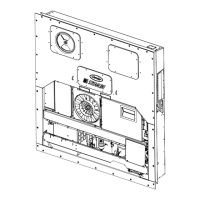
